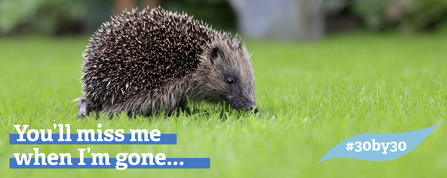A year ago today, The Wildlife Trusts launched a vision to put nature into recovery across at least 30% of land and sea by 2030 and started an appeal to raise £30 million to begin the work. Today we are delighted to announced that in just twelve months we have raised over £25 million. 35 important nature recovery projects are underway to restore land for wildlife.
The UK is one of the most nature-depleted countries in the world, with once-common creatures such as hedgehogs, red squirrels and sparrows now critically endangered, and huge reductions in the abundance of wildlife across the board. The Wildlife Trusts are determined to reverse the trend.
Craig Bennett, Chief Executive, The Wildlife Trusts said: “We are thrilled to have raised £25 million in the past year to fund our vision for 30 by 30 and we’re extremely grateful to every single person who has helped make this happen. It’s fantastic that people want to support our work to reverse wildlife declines and address the climate emergency.
But this is only the first step to mend our broken natural world by 2030. While The Wildlife Trusts are taking urgent action, some aspects of the Government’s agenda threaten to undermine good work on the ground, by weakening habitat regulations which protect wildlife, weakening the planning rules that guard the environment, and shrinking the powers and resources needed by the Environment Agency to stop river pollution.
The Government needs to invest far more in nature – we know that more than a £1 billion annually is needed to create and restore wild places. A recent report found that only about 3% of land in England is genuinely protected for nature – yet the Government wrongly persists in claiming the amount protected is 26%. It’s time they faced the huge scale of the task and stumped up the funds to match.”
Coincidentally, the Government launched a 30 by 30 vision on the same day as The Wildlife Trusts a year ago – but believes that far more land is protected for nature than is the reality. The Wildlife Trusts maintain that National Parks and Areas of Outstanding Natural Beauty – which the Government says count towards 30% – are landscape not wildlife designations, and many of these places are severely depleted of nature. While National Parks and AONBs contain some high-quality natural areas, they cannot count in their entirety towards 30%. Only those areas which are protected and well managed for nature should be included.
The Wildlife Trusts are calling for a new designation in England, Wildbelt, to protect land that is put into recovery for nature.
The Wildlife Trusts’ latest 30 by 30 projects include:
· Pewley Down Fields – Surrey Wildlife Trust: Acquisition of rare chalk grassland, home to skylarks and rare butterflies, saved by rapid community action
· Pencnwc Mawr Wood – The Wildlife Trust of South and West Wales: Increasing the size of a rare Welsh temperate woodland, scarcer than tropical rainforest
· Astonbury Wood – Herts and Middlesex Wildlife Trust: Purchase of long-term lease to manage this irreplaceable ancient woodland and secure its future for nature
· Peatland Progress – Cambridgeshire Wildlife Trust: Pioneering work on a grand scale tackling climate change, biodiversity loss and eco-anxiety
· Honeygar – Somerset Wildlife Trust: Nature is getting to work on this former dairy farm by re-wetting drained peat soils to lock-up carbon
· Wild Woodbury– Dorset Wildlife Trust: Wild Woodbury is England’s first large-scale community rewilding project on former farmland
President of The Wildlife Trusts, broadcaster and biologist, Liz Bonnin said: “I'm incredibly proud of The Wildlife Trusts and everyone involved in raising this astonishing sum in such a short time – it just goes to show how much we really do care about the natural world and our precious wildlife. Together, we can bring nature back – and we can do it at the scale needed to address our biodiversity and climate crises. A heartfelt thank you for supporting the magnificent work of the Trusts and the inspirational projects that will get us there. Time to roll up our sleeves and get the job done!”
Today, The Wildlife Trusts unveil a new online map which gives examples of a range of projects underway to achieve nature’s recovery. Nature needs more, bigger, wilder landscapes that are joined together to allow wildlife to thrive, rebuild natural abundance and help species and habitats adapt to climate change. The projects include nature-friendly farmland, urban green spaces, gardens, woodlands, rivers, nature reserves and more. View the map HERE. The Wildlife Trusts’ 30 by 30 appeal asks people, individuals, corporates and communities to donate here.

